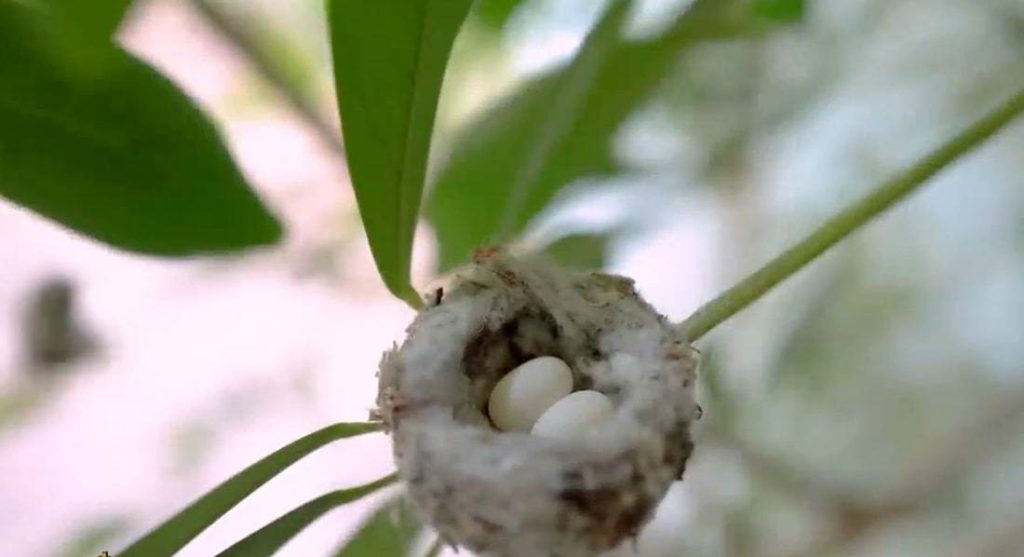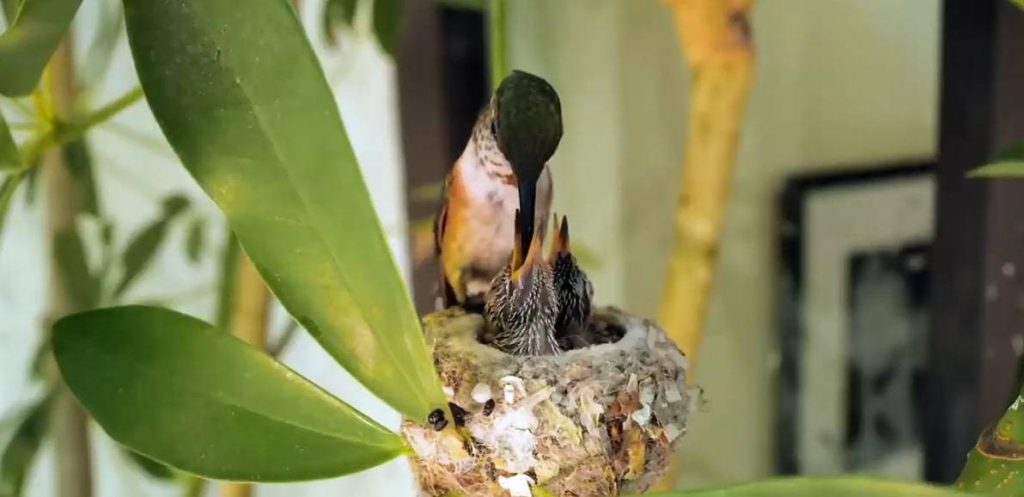Hummingbirds, these tiny marvels of nature, captivate us with their iridescent feathers and dazzling aerial acrobatics. But their nesting habits are equally fascinating, showcasing a remarkable feat of engineering in a miniature package.
As bird enthusiasts, we can appreciate the intricate hummingbird nest from afar, learning about the materials, construction process, and the timing of their nesting cycle.
What Do Hummingbird Nests Look Like?

Imagine a thimble, meticulously woven from nature’s softest treasures. That’s the essence of a hummingbird house!
These tiny cups, cradling the next generation of these dazzling aviators, are marvels of miniature architecture. Typically no larger than a walnut, they measure around 2 inches in diameter and 1-1.5 inches deep.
The shape is a compact cup, designed for maximum comfort and security for the developing chicks. The base is a fascinating feat of engineering.
Hummingbirds incorporate plant fibers and lichens, creating a spongy floor that ingeniously expands as the chicks grow rapidly inside. The sides are equally impressive, woven with a touch of elasticity thanks to spider silk.
This remarkable material acts like a flexible binding, allowing the nest to gently stretch and adapt to the chicks’ increasing size.
But the true artistry lies in the camouflage. The exterior of the nest is a masterpiece of nature’s disguise. Hummingbirds weave in soft materials like moss, lichen, and plant down.
These natural elements perfectly blend the nest into the surrounding foliage, creating a near-invisible cradle for their young. This camouflage offers precious protection from predators, keeping the nest hidden from curious eyes.
Additionally, the interwoven materials help regulate the temperature within the tiny cup, ensuring a comfortable haven for the developing chicks.
Do Hummingbirds Use The Same Nest Every Year?
Generally, hummingbirds do not reuse nests from year to year. This is likely due to several factors. First, the nests are quite delicate and may not withstand the elements over a long period.
Due to their high-energy lifestyle, hummingbirds may migrate long distances, returning to a different location the following season.
However, there have been documented cases where hummingbirds have reused nests, particularly in areas with abundant resources and mild winters. In such instances, the female may simply add new lining materials to the existing structure before laying her eggs.
What Time Of Year Do Hummingbirds Nest?
The timing of hummingbird nesting varies depending on the specific species and geographical location. In warmer climates with readily available food sources, nesting can begin as early as February or March.
In regions with colder winters and shorter breeding seasons, nesting may occur from May to July.
Hummingbirds typically raise two broods per season, though some species may attempt a third brood depending on environmental conditions. The female will initiate nest building shortly before laying eggs, and the entire nesting cycle, from construction to fledging, can take as little as 35 days.
How Long Does A Hummingbird Sit On Her Nest?

The incubation period for hummingbird eggs is remarkably short, lasting only 12-14 days.
The female hummingbird takes sole responsibility for incubation, remaining in the nest for most of the day. She may leave briefly to feed but will return quickly to ensure the eggs stay warm.
Once the chicks hatch, the female continues to brood them for warmth and protection for another week or so.
After that, she focuses on feeding the chicks and making frequent trips to gather nectar and tiny insects. The chicks remain in the nest for 18-25 days before taking their first flight.
How Do Hummingbirds Build Their Nests?
The construction of a hummingbird nest is an intricate process, showcasing the remarkable resourcefulness of these tiny birds. Here’s a breakdown of the key steps:
Site Selection
The female hummingbird takes the lead in selecting a nesting site. She favors sheltered locations on trees or shrubs, often choosing a fork in a branch for added support.
The nest is typically built 10-90 feet above the ground, offering protection from predators and harsh weather.
Gathering Materials
Hummingbirds are meticulous architects, utilizing a variety of soft and lightweight materials for their nests. These include:
- Twigs and plant fibers: These provide the initial framework for the nest.
- Spider silk: This remarkable material acts as a binding agent, strengthening the nest and anchoring it to the branch. Hummingbirds are adept at collecting spider silk, often incorporating it throughout the construction process.
- Moss, lichen, and plant down: These soft materials provide insulation and camouflage, creating a cozy and secure environment for the eggs and chicks.
- Feathers: Occasionally, hummingbirds may incorporate feathers, particularly their down feathers, into the nest lining for added warmth.
Construction Process
The female hummingbird takes around 5-7 days to build the nest. That’s not surprising, given the hummingbird nest size.
The female meticulously weaves the materials together, shaping them into a cup-like structure. Spider silk plays a crucial role in binding the elements and adding strength and elasticity to the nest.
What Kind Of Trees Do Hummingbirds Like To Nest In?
Hummingbirds don’t exhibit a strong preference for any specific tree species when nesting. However, they do favor locations that offer certain characteristics:
- Shelter: The nesting site should be sheltered from strong winds, rain, and direct sunlight. Trees or shrubs with dense foliage provide ideal cover.
- Support: The branch chosen for the nest needs to be sturdy enough to support the weight of the nest and the developing chicks. Deciduous trees or shrubs with a network of branches are often preferred.
- Accessibility: The female hummingbird needs easy access to the nest for entering and exiting. She also requires a clear flight path to approach the nest with food for the chicks. Branches that are relatively open and free of obstructions are ideal.
How Do You Know If Hummingbirds Are Nesting?
Spotting a hummingbird nesting box can be challenging due to their small size and excellent camouflage. However, some signs might indicate nesting activity:
Increased Hummingbird Activity
If you notice a sudden increase in hummingbird activity around a particular tree or shrub, particularly early in the morning or late afternoon, it could be a nesting site. The female will be making frequent trips to gather nesting materials or feed the chicks.
Presences Near Specific Branches
Observe if hummingbirds are spending a significant amount of time hovering or perching near specific branches on a tree or shrub. This could indicate the location of a nest.
Distinctive Buzzing Sound
During incubation, the female hummingbird may make a soft buzzing sound while sitting on the nest. This sound is not always audible, but it can be a clue if you’re positioned very close to the nest. It’s important to remember that observing a nest from a distance is crucial.
Avoid disturbing the nest or the nesting hummingbirds. If you suspect there might be a nest in your yard, maintain a respectful distance and avoid excessive noise or activity near the area.
Final Thoughts
The intricate world of hummingbird nesting is a testament to the remarkable adaptations of these tiny birds.
From the selection of materials to the meticulous construction process, each step showcases their ingenuity and dedication to raising their young.
As bird enthusiasts, appreciating these marvels of nature allows us to coexist peacefully with these fascinating creatures and create a welcoming environment for them to thrive.

